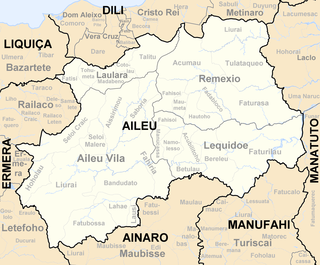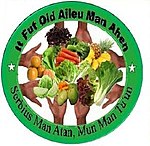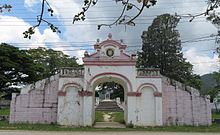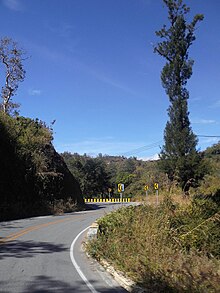Aileu (municipality)
|
Munisípiu Aileu (tetum) Município de Aileu (port.) |
||

|
||
| Data | ||
| Capital | Aileu | |
| surface | 735.94 km² (10.) | |
| Population (2015) | 48,837 (12.) | |
| Population density | 66.36 inh / km² (8.) | |
| Number of households (2015) | 7,598 (11.) | |
| ISO 3166-2: | TL-AL | |
| Administrative offices | Residents | surface |
| Aileu | 24,049 | 320.99 km² |
| Laulara | 7,090 | 66.73 km² |
| Lequidoe | 6,765 | 49.2 km² |
| Remexio | 10,933 | 210.86 km² |
| map | ||

|
||
Aileu is a municipality in East Timor . The capital of the municipality is the eponymous Aileu in Suco Seloi Malere, which is classified as urban . The administrative unit was only created in the last years of the Portuguese colonial era.
Surname
Aileu means "curved tree" in the local Mambai language . A small monument with an "A" formed from roots, which is supposed to remind of the legend behind it, is located in Suco Liurai .
geography
Aileu is located in the highlands of the northwest of East Timor and is one of the two communities without access to the sea. Since the territorial reform of 2015, the municipality has an area of 735.94 km² (previously 676.02 km²). The mountainous landscape is between 350 and 1500 m above sea level. Aileu is bordered by the municipality of Dili to the north, Manatuto to the east, Manufahi to the southeast, Ainaro to the south, Ermera to the west and Liquiçá to the northwest .
The municipality is divided into the administrative offices of Aileu , Laulara , Lequidoe and Remexio .
Aileu traditionally distinguishes four seasons. From mid-October to April is the rainy season, May and June is the cold season. July and August are very windy and the dry season takes place between mid-August and mid-October. Due to the altitude, the average temperatures are significantly lower and the humidity lower than in the coastal regions of East Timor. The maximum temperature is 29 ° C, at night the temperature can drop to 4 ° C.
Residents
48,837 (2015, 2011: 46,569 inhabitants) live in Aileu. Almost half of them live in the administrative office of Aileu, the most densely populated is Laulara with 106.2 inhabitants per square kilometer (2010, 2004: 90). The total population density is 74.9 inhabitants per square kilometer. The average age is 17.7 years (2010). The population in the municipality of Aileu is even younger than the national average (18.8).
In Aileu women have the most children on average in East Timor, where the fertility rate in 2004 was among the highest in the world. The administrative office Remexio holds the top nationwide with 9.92 children per woman, Laulara is in second place with 9.90 children. In the administrative office of Aileu there are 9.25 and in Liquidoe “only” 7.88 children per woman (national average 6.99). Between 1990 and 2004 the number of inhabitants grew annually by 3.08%. The infant mortality rate in 2002 in Laulara was 122 deaths per 1000 live births (1996: 134), in Aileu 105 (153), in Liquidoe 97 (148) and in Remexio 94 (138). The national average was 98.
68.8% (2015) of the population in the community speak the national language Mambai as their mother tongue . In Acumau and Talitu there is a minority of Lolein -Sprechern (1.1% of the population in the community). The rest mainly speak Tetum , especially the Tetum Prasa dialect (29.0%). In the northeast, on the border with Manatuto, Galoli was traditionally spoken in the past . In the 2015 census, however, only eleven residents of the community said they had Galoli as their mother tongue. If the second languages are also taken into account, in 2015 95.0% spoke Tetum, 29.3% Bahasa Indonesia, 34.4% Portuguese and 15.1% English .
In 2015, 92.1% of the population were Catholics, which is well below the national average. The proportion of Protestants with 7.3% and followers of the traditional, animistic religion of Timor with 0.4% are higher. The old Glauebn still has a strong influence. In some villages, such as Hohulo and Erhetu , there are still practicing spiritual centers.
In 2015, 43.4% of residents aged three or over attended school. 30.9% had left school. 24.5% have never attended school. The proportion of the latter in Aileu is below the national average. There are also more students. However, 4.7% of the residents only attended pre-school, a third went to primary school. Just under another third of the population have completed secondary schools. Only 4.4% have a diploma or a degree; the national average is 7.0%. The illiteracy rate in 2015 was 14.7% (women: 14.3%; men: 15.1%). In 2004 it was still 60.9%.
| Education | Graduation | ||||||||||
| at school | Finished school | never in a school | Preschool | primary school | Pre- secondary |
Secondary | Diploma / University of Applied Sciences |
university | No graduation | ||
| Women | 43.1% | 28.1% | 27.6% | 4.6% | 31.8% | 14.1% | 14.2% | 0.5% | 3.2% | 0.8% | |
| Men | 43.7% | 33.5% | 21.6 | 4.7% | 37.3% | 13.4% | 14.1% | 0.6% | 4.3% | 0.7% | |
| total | 43.4% | 30.9% | 24.5% | 4.7% | 34.6% | 13.7% | 14.1% | 0.6% | 3.8% | 0.7% | |
history
To the southeast of Aileu was the kingdom of Dailor , one of the many traditional kingdoms of Timor that was ruled by a Liurai . It appears, as does Caimau , on a list of Afonso de Castro , a former governor of Portuguese Timor who listed 47 empires in 1868. In January 1894 Dailor signed a written treaty with Portugal on his vassal status to the colonial power.
In 1903 a revolt against the Portuguese broke out in Aileu, but it was quickly suppressed. In 1912, Aileu served as the Portuguese base during the Manufahi Rebellion .
Between 1942 and 1945 , the Japanese occupied Portuguese Timor . On August 20, 1942, Aileu was occupied by 300 Colunas Negras , Timorese allies of the Japanese invaders. On August 31, they killed five Portuguese soldiers and four other Portuguese officials and missionaries. Japan blamed this, as well as other incidents, on "a group of West Timorese " who wanted to settle in the east and were mistreated by the Portuguese. A memorial in Hauptstrasse still commemorates the massacre . This monument remained untouched during the Indonesian occupation.
From 1942 to 1971 Aileu was part of the administrative district (conselho) of Dili. It was not until 1973 that the Aileu district was founded with Aileu, Remexio, Lequidoe and Laulara.
In 1975, Aileu was one of the centers of the FRETILIN independence party . Here, the FRETILIN leaders gathered after the coup attempt of the UDT on August 11 to auszuholen to strike back. After the Indonesian invasion , a few months later, many residents of the city of Aileu, which was occupied by the Indonesians on December 31, fled to the mountains. The localities in the region remained uninhabited for several years. At first only the area around the city of Aileus and the highways to Dili , Gleno / Ermera and Maubisse were occupied. In Remexio a base de apoio was built in which the refugee civilian population was settled by the FALINTIL resistance movement . From September 1977 the Indonesian army advanced into western Aileu and occupied it completely until February 1978. Between May and June 1978, eastern Aileu also fell under Indonesian control. The base in Remexio was destroyed, people dispersed or captured. During the occupation, residents of the region around Maubisse were resettled in what was then the Aileu district . There was therefore tension between long-time residents and new settlers. The situation was also explosive as the residents Maubisse and Aileu had traditionally been enemies before.
After the referendum in 1999, in which the population voted for independence from Indonesia, there were outbreaks of violence across the country by pro-Indonesian militias . In Aileu, the destruction was particularly severe in the former sub-districts of Liquidoe and Laulara. The capital Aileu was also badly affected. Only a few buildings remained undamaged. Water and electricity supplies were destroyed in the entire Aileu district and around 5,000 people had fled to West Timor . Eventually the international intervention force INTERFET was deployed and East Timor was placed under UN administration . Fighters from the East Timorese resistance movement FALINTIL were barracked in the city of Aileu until February 2001. Then 600 of the fighters began training to become soldiers of the New East Timorese Defense Forces (F-FDTL).
Between 2006 and 2008, Aileu was one of the regions where rebel leader Alfredo Alves Reinado hid with his men until he was killed in an attack on the state leadership on February 11, 2008. The rebel movement then dissolved.
In 2014, the districts across East Timor were transformed into "parishes" and the sub-districts into "administrative offices".
politics
| Administrador Konsellu |
|
|---|---|
| Alfredo Pires | 1973-1975 |
|
District President (Bupati) |
|
| Abel dos Santos Fátima (UDT) | 1976-1989 |
| Fernão Verdial | 1989-1994 |
| Waluyo (military) | 1994 |
| Suprapto Tarman (military) | 1994-1999 |
|
Civil Administrator |
|
| Sue Ingram | 2000 |
| Maria da Paixão da Costa | 2000–2002 (?) |
|
Administrador |
|
| Antonio da Costa Belo | 2002-2004 |
| Martinho Sequira Alves Matos | 2004-2016 |
| João Tilman do Rego | since Jan. 2016 |
The administrator ( Administrador ) is appointed by the state government in Dili. The current administrator João Tilman do Rego has been in office since January 2016.

In the elections for the constituent assembly , from which the national parliament later emerged, FRETILIN in Aileu won the most votes with 21.15%, so that it received the direct mandate at that time. In the 2007 parliamentary elections , the Coligação ASDT / PSD succeeded in becoming the strongest force in Aileu with 46.4% of the vote. In the parliamentary elections in 2012 , the Congresso Nacional da Reconstrução Timorense (CNRT) received 52.5%. Only in Aileu did the CNRT succeed in gaining an absolute majority in one of the districts of the time in this election. In 2017 , the CNRT remained the strongest force in Aileu with 40.9%. In the early elections in 2018 , the Aliança para Mudança e Progresso (AMP) , to which the CNRT now belonged, received 59.6% of the votes.
In the first round of the presidential elections in 2007 , Francisco Xavier do Amaral from the ASDT in Aileu was able to collect 64.9% of the votes, but was eliminated in fourth place nationwide. In the second round, the non-party José Ramos-Horta won 93.9%. In 2012 Ramos-Horta won the first ballot in Aileu, but was eliminated as third-place nationwide. The second round in Aileu went to election winner Taur Matan Ruak with 70.8%. In the 2017 presidential elections in Aileu, the nationwide winner Francisco Guterres from FRETILIN won the most votes.
Symbols
The Aileus emblem has been in use since 2014, a green circle in which eight hands gather fruit and vegetables. Each pair of hands represents one of the administrative offices of the municipality. The motto is kept in Mambai. It means: "Building together Aileu for a better future - work like a slave, eat like a king". In addition, the symbol of aileus is often used to refer to the meaning of the community name with an "A" formed from twisted roots.
economy

According to the 2010 census, 51% of all residents who are ten years or older work (national average: 42%). 1% are unemployed (5%). Since there is no industry, 83.7% of households practice arable farming, 95.3% cattle. It is mainly grown for personal use. Coffee , oranges, mangoes and other fruits are cultivated as commodities . 69% of the families in the community grow coffee, making Aileu one of the centers of Timorese coffee growing. At the top are the administrative offices of Laulara and Ailleu. The coffee harvest is sold to the Cooperativa Café Timor (CCT). The most important food crop is cassava, which is grown by 79% of households (production 2008: 2,940 t). Cassava is planted on slash-and-burn areas shortly before the start of the rainy season and, depending on the Aileus region, takes one to three years to be harvested at the start of the dry season.
79% of households also grow maize (753 t). This is where sowing takes place at the beginning of the rainy season. The fast-growing species is then harvested in the middle of the rainy season, the long-growing species only towards the end.
In the administrative office of Aileu, rice (931 t) is grown by irrigation in the river valleys (20% of all households in the municipality). The centers here are the Daisoli river and the Aileu river system in Suco Seloi Craic . While there is only one harvest in Seloi Craic, depending on the variety, in June and July, in Sarin you can also harvest rice in January that has ripened over the dry season.
Pigeon peas , sweet potatoes and peanuts also grow during the rainy season . In addition, coconuts, beans and other vegetables and fruits are harvested (a total of 2,342 t). As pets, people mainly keep chickens (2010: 23,687 in 76% of households) and pigs (12,638, 82%). In addition, goats (5,928.40%), cattle (4,697, 31%), horses (2,462, 24%), water buffalo (1,782, 12%) and sheep (830, 3%).
Due to drought, vermin and plant diseases, there was an acute food shortage in East Timor in 2007, which persisted for a long time, especially in the then Aileu district. In 2008, as in 2001, heavy rains caused further losses in the harvest.
There are no economically usable forest areas in the municipality. The last stocks can still be found in the valleys and on the slopes of the Laulara and Remexio administrative offices. In Remexio there are the last remains of sandalwood stocks , which in earlier centuries were the main export good of the island of Timor. Otherwise, trees are only found to provide shade for coffee plantations . The inhabitants use the wood as building material and fuel, which further drives deforestation . Reforestation programs have started. No mineral resources are extracted in Aileu, with the exception of clay for ceramics and bricks. There is an undeveloped marble deposit in Liquidoe .
The local radio station is Radio Communidade Rai Husar (Radio Aileu) on FM 97.1 MHz. The FRETILIN radio station, Radio Ma 2500, can be received from Ainaro on FM 97.9 MHz.
Web links
- Administration of the municipality of Aileu: Planu Estratejiku Desenvolvimentu Munisipal 2015 (tetum), Ministry of State Administration and Territorial Management
supporting documents
- Ministry of State Administration and Territorial Management
- Aileu District Development Plan 2002/2003 (English, PDF file; 1.07 MB)
- District Profile August 2013 (tetum, PDF file)
Individual evidence
- ↑ a b c d e f g h i j k l m n o p q Direcção-Geral de Estatística : Results of the 2015 census , accessed on November 23, 2016.
- ↑ Geoffrey Hull : The placenames of East Timor , in: Placenames Australia (ANPS): Newsletter of the Australian National Placenames Survey, June 2006, pp. 6 & 7, ( Memento of February 14, 2017 in the Internet Archive ). September 2014.
- ↑ a b Direcção Nacional de Estatística: 2010 Census Wall Chart (English) ( Memento from August 12, 2011 in the Internet Archive ) (PDF; 2.7 MB)
- ↑ a b c d e f g h Munisipio Aileu: Planu Estartejiku Desenvolvimentu Munisipal (tetum), accessed on February 15, 2016.
- ↑ Direcção Nacional de Estatística: Timor-Leste in figures 2011 (PDF; 3.8 MB) ( Memento from February 19, 2014 in the Internet Archive ), accessed on May 5, 2013
- ↑ a b c Census of Population and Housing Atlas 2004 ( Memento of November 13, 2012 in the Internet Archive ) (PDF; 14 MB)
- ↑ Um pouco de história ( Memento from 20091217210557)
- ↑ East Timor - PORTUGUESE DEPENDENCY OF EAST TIMOR ( Memento of 21 February 2004 at the Internet Archive ) in the Internet Archive
- ↑ a b c History of Timor - Technical University of Lisbon ( Memento of the original from March 24, 2009 in the Internet Archive ) Info: The archive link was inserted automatically and has not yet been checked. Please check the original and archive link according to the instructions and then remove this notice. (PDF; 824 kB)
- ↑ Kisho Tsuchiya: Indigenization of the Pacific War in Timor Island: A Multi-language Study of its Contexts and Impact , p. 13, Journal War & Society, Vol. 38, No. February 1, 2018.
- ^ Government of Timor-Leste: Administrative Division (English)
- ↑ "Chapter 7.3 Forced Displacement and Famine" ( Memento of November 28, 2015 in the Internet Archive ) (PDF; 1.3 MB) from the "Chega!" Report of the CAVR (English)
- ↑ "Part 4: Regime of Occupation" ( Memento of January 18, 2012 in the Internet Archive ) (PDF) from the "Chega!" Report of the CAVR (English)
- ↑ RTP: Missão da ONU em Timor-Leste nicht preparou adequadamente funções de Governo denuncia académica , June 24, 2019 , accessed on June 25, 2019.
- ↑ http://www.jornal.gov.tl/lawsTL/UNTAET-Law/Notifications English / Not2000-18.pdf (link not available)
- ↑ World Bank: Participation List Timor-Leste and Development Partners Meeting 3-5 December 2003 , accessed April 27, 2020.
- ^ Website of the East Timorese government: The Aileu District Administrator speaks about the NSDP
- ↑ Friends of Aileu, Aileu continues its journey towards decentralization , Update No. 43, April 2016 , accessed May 14, 2016.
- ↑ Lurdes Silva-Carneiro de Sousa: Some Facts and Comments on the East Timor 2001 Constituent Assembly Election ( Memento of October 16, 2013 in the Internet Archive ) ( RTF ; 199 kB), Lusotopie 2001: pp. 299–311.
- ↑ CNE - official results on 9th July 2007 ( Memento from September 27, 2007 in the Internet Archive ) (PDF file; 118 kB)
- ↑ CNE: CNE 2017
- ↑ CNE: Munisipios , accessed May 30, 2018.
- ↑ Planu Estratejiku Desenvolvimentu Munisipal 2015, p. 3
- ↑ a b c Direcção Nacional de Estatística: Suco Report Volume 4 ( Memento from April 9, 2015 in the Internet Archive ) (English; PDF file; 9.35 MB)
- ↑ Seeds of Life: Cassava: Aileu District (English)
- ↑ Seeds of Life: Maize: Aileu District (English)
- ↑ Seeds of Life: Irrigated Rice: Aileu District (English)
- ↑ Seeds of Life: Pigeon Pea: Aileu District (English)
- ↑ Seeds of Life: Sweet Potato: Aileu District (English)
- ↑ Seeds of Life: Peanuts: Aileu District (English)
- ↑ Direcção Nacional de Estatística: Timor-Leste in Figures 2008 ( Memento of 7 July 2010 in the Internet Archive ) (PDF; 3.7 MB)
- ↑ ARKTL - Asosiasaun Radio Komunidade Timor-Leste (English)
Coordinates: 8 ° 43 ' S , 125 ° 34' E















